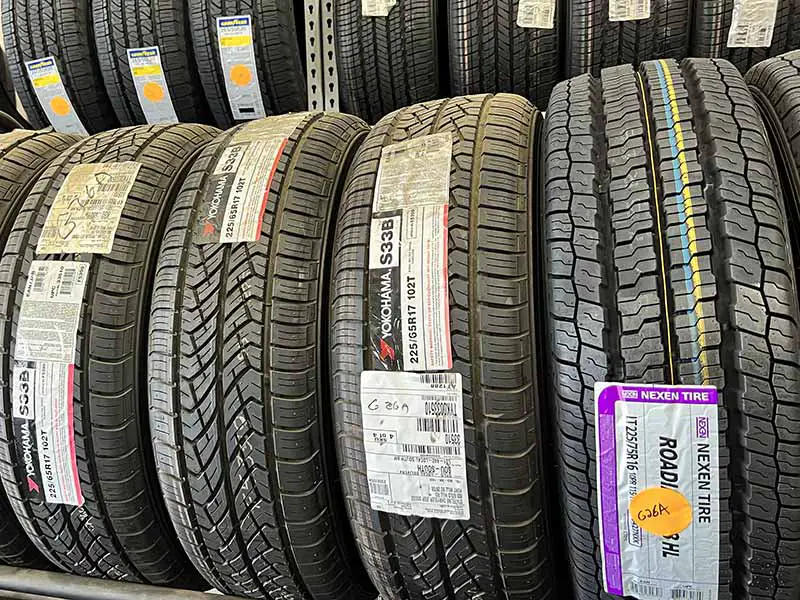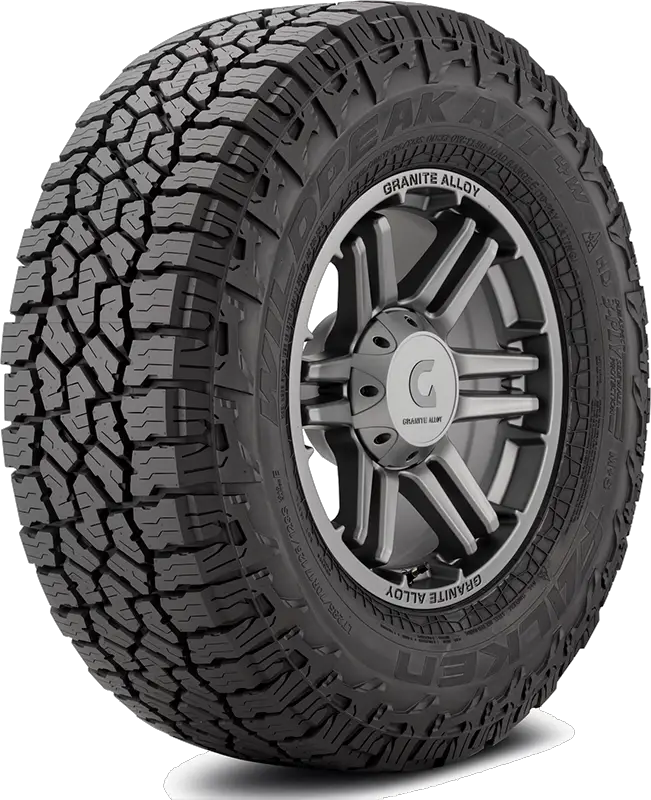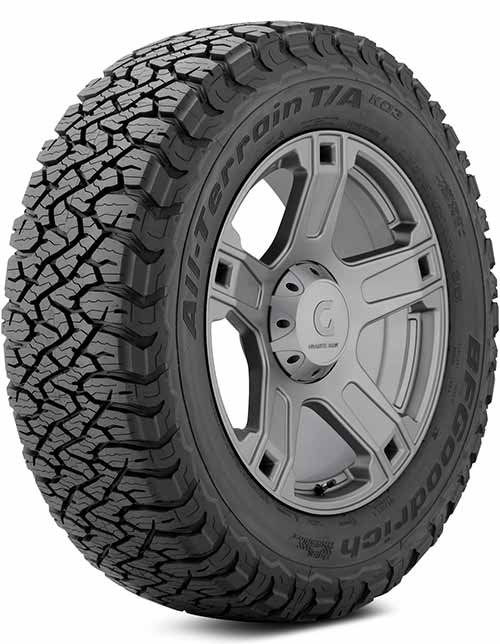What do the numbers and letters on tires mean? Tire size specifications can seem overwhelming if you’re not familiar, but they really aren’t too difficult to understand with a little help.
In this article we will break down the meaning of each tire size measurement in plain English and include some helpful illustrations so you can easily understand what everything means.
- We’ll cover the basic tire size specification that includes the basic tire width, sidewall height (aspect ratio), and wheel diameter.
- We’ll then cover the complete tire size specification that includes less well-known tire size meanings such as load index and speed ratings.
- Finally, we’ll cover other tire sidewall markings such as the DOT tire identification number and the Uniform Tire Quality Grade rating.
First, let’s start with the basics.
How To Read Tire Size
What do the 3 numbers mean on tire size? Tire size is measured primarily by 3 numbers. These numbers represent the tire width, sidewall height, and wheel diameter.
Example: 235/45 18
- Section Width (Tire Width)
- Aspect Ratio (Profile/Sidewall Height)
- Rim Diameter (Wheel Size)
These aren’t the only tire size markings on the tire’s sidewall. There’s a lot more to tire size than a tire’s width and height. We’ll break them all down for you.
Let’s take a closer look.
Tire Size Meaning
We’ve given you the high level overview of the 3 main tire measurement numbers.
Basic Example: 235/45 18
The 3 main tire measurements don’t cover all of the tire measurements listed on a tire’s sidewall. A more complete example of tire size is shown below.
Complete Example: P 235/45 R18 95 V
It contains a lot more letters and numbers but don’t worry. We’ll break down each one in the most simple of terms. It looks a lot more complex than it really is.
Let’s now dive a little deeper into each of the 3 main measurements and explain the other lesser-known tire measurements.
We’ll start from the left of the complete tire size example and work our way across until we’ve covered every number and symbol of a complete tire size specification.
Tire Classifications
Example: P 235/45 R18 95 V
There are 4 classifications of tires:
- P – Passenger
- LT – Light Truck
- ST – Special Trailer
- T – Temporary
These are fairly self-explanatory but there are some important details to understand when it comes to these different classifications of tires.
P – Passenger Tire
Passenger car tires are generally not meant for trucks and large vehicles, but that doesn’t mean what you may consider a truck. For instance, smaller SUVs may use standard passenger car tires since they don’t have the need to use a tire designed for unusually heavy loads or excessively heavy vehicles.
LT – Light Truck Tire
Light trucks have less of a need for vehicle handling performance advantages and more load carrying capacity. This can be due to their use as work trucks carrying heavy material loads, the need for frequent strength due to towing needs, or simply the weight of the much larger vehicle design.
Adequate grip is still important so they are usually still radial construction.
ST – Special Trailer Tire
Trailers have little need for the same handling characteristics that passenger car tires need, or even light truck tires.
Because of this, they usually have fairly simple tread patterns and are designed with bias ply construction.
T – Temporary Spare Tire
Temporary spare tires are designed to be used only in emergency situations and are not designed to be driven on for more than 50 miles or at speeds greater than 50 miles per hour.
These may be full size tires, space saver donuts, or collapsible designs that need to be inflated before being used.
Learn More About Tire Classifications
Section Width
Example: P 235/45 R18 95 V
The section width is represented in millimeters. Our example tire measurement is 235mm wide from sidewall to sidewall.
Section Width Vs Tread Width
The section width of the tire is the measurement of the sidewall to sidewall. This is usually slightly wider than the tread width. It can sometimes even be wider than the rim width. This is because the width of the tire can bulge slightly beyond the width of the wheel lip.
The tread width is the measurement of the tread face from sidewall to sidewall. Tire sizes do not display tread width measurements and there are no markings on tire sidewalls of any kind to indicate this measurement. Tread width is essentially the same as the section width but slight less. The amount less than the section width varies between tire designs.
NOTE: It’s important to point out however that Section Width and Tread Width are naming conventions that are often used interchangeably, but technically speaking they are in fact slightly different. Even my image above has the term Tread Width when Section Width is the more accurate term. It’s a confusing topic made more so by the naming conventions being used inconsistently, even by myself! Thanks for pointing this out Warren. 😉
Learn More About Section Width
Aspect Ratio
Example: P 235/45 R18 95 V
The aspect ratio of the tire is the measurement of the sidewall height. This is sometimes referred to as the section height.
The aspect ratio is represented as a percentage of the section width. Our example tire measurement is 45% of 235mm from wheel lip to tread surface. Some quick math gives us 105.75mm.
Construction
Example: P 235/45 R18 95 V
The construction of a tire isn’t a measurement, but an indicator of the design of the internal construction of the tire. There are only two common construction methods used today – Radial and Bias Ply.
Radial tire construction is almost exclusively used on cars and trucks. Bias constructed tires are usually only for trailer tires or situations where a tire needs a stronger sidewall.
Radial Tires – R
A radial tire has cords oriented perpendicular to the direction of travel. In other words, they are oriented in a radial pattern.
The advantage of a radial tire is it allows the sidewall to flex while the tread can better remain in contact with the road surface.
Bias Ply Tires – D or B
Bias Ply tire construction is used on trailer tires or tires that need to have a stronger sidewall construction. They have cords oriented at diagonal angles compared to the direction of travel.
Bias ply tires are an older method of tire construction and can still be purchased for use on antique cars. Otherwise, they are not in wide use as passenger tires.
The letter “D” in the tire size of a bias ply tire stands for “Diagonal”. More advanced bias ply tires use the letter “B” for “Belted”. Belted Bias Ply tires add layers of belts on top of the diagonal plies to add strength and improve tread wear.
Learn More About Tire Construction
Rim/Wheel Diameter
Example: P 235/45 R18 95 V
The rim diameter of the tire is the wheel size the tires are designed to be mounted onto. This is sometimes referred to as the wheel width.
The rim diameter is represented in inches. Our example tire measurement is 18″ from wheel lip to wheel lip across the center of the face of the wheel.
Learn More About Wheel Diameter
Load Index
Example: P 235/45 R18 95 V
The load index is a number that correlates to the maximum amount of weight that the tire is capable of supporting safely when inflated to the proper pressure.
Load index is usually a number between 75 and 100, although there are load index ratings much higher that are available.
A load index of 95 is capable of supporting 1521 pounds when properly inflated. If you would like to look up a specific load index, you can do so using this load index chart.
Learn More About Tire Load Index
Speed Rating
Example: P 235/45 R18 95 V
The speed rating of a tire is an indication of how fast the tire can be safely driven on without the tire failing due to the extreme forces.
A tire’s speed rating is indicated by a single letter. Generally speaking, the higher the later in the alphabet, the higher the speed rating.
There are a few exceptions. H, W, and Y. W and Y are each a speed rating beyond Z. The H speed rating is slotted between the U and V speed ratings.
For specific speed rating numbers you can check out Discount Tire’s speed rating chart.
Learn More About Tire Speed Ratings
Additional Tire Sidewall Markings
A tire’s sidewall has more than just size information. There are two other symbol groupings that contain a lot of helpful information.
Uniform Tire Quality Grading (UTQG Meaning)
Example: 500AA
UTQG is an acronym for Federal Government’s Uniform Tire Quality Grading Standard that is used to categorize tire quality. It however doesn’t cover winter tires since these factors are very different in winter environments.
UTQG is a group of 3 measurements of a tire’s performance.
Treadwear Grade
Example: 500AA
The treadwear grade is an attempt to measure how long a tire will last. The higher the number the longer it should be expected to last.
The range to expect tires to fall within is 100-1000.
Traction Grade
Example: 500AA
The traction rating of a tire is an attempt to measure how well a tire will grip in wet weather conditions.
There are four possible ratings:
- AA
- A
- B
- C
AA is the best possible wet traction rating and C is the worst possible wet traction rating.
Temperature Grade
Example: 500AA
The temperature rating of a tire is an attempt to measure how well a tire can resist heat buildup at higher speeds.
There are three possible ratings:
- A
- B
- C
A is the best possible temperature rating and C is the worst possible temperature rating.
DOT Tire Codes (Tire Identification Number)
The Department of Transportation code is essentially a serial number for your tire.
Example: DOT B9 EL 04EX 4118
The DOT Code always begins with the letters DOT. The following are the meanings of each segment:
Plant Code
Example: DOT B9 EL 04EX 4118
Tire manufacturers are assigned a code for every manufacturing plant and this code is used for the beginning of the DOT code.
Tire Size
Example: DOT B9 EL 04EX 4118
The tire size sequence is the next grouping of letters and numbers. It isn’t likely to be of any use to you and really more of an internal designation. You’re much better off ignoring this and focusing on the more common tire size listed more prominently on the tire’s sidewall.
Brand Code
Example: DOT B9 EL 04EX 4118
The tire manufacturer’s code is the next in the sequence and is usually three letters.
Manufacture Week
Example: DOT B9 EL 04EX 4118
The most important portion of the DOT code is the manufacture date. Tires should generally be discarded after six years no matter how much tread life is left. This includes tires that have never been used.
The first two digits of the last segment in the sequence are the week of the year the tire was manufactured.
Manufacture Year
Example: DOT B9 EL 04EX 4118
The last two digits of the last segment in the sequence are the year the tire was manufactured.
Mud + Snow (M+S)
Tires with an M+S symbol on the side are rated for use in mud and light snow. These tires are all-season tires and not suitable for use in areas that require a dedicated winter tire.
They are a great choice for use in regions that see less than a few inches of snow annually and don’t experience temperatures below 45ºF for extended periods of time.
3-Peak Mountain Snowflake
Tires with the 3-peak mountain snowflake symbol molded into the tire’s sidewall are tires that have been rigorously tested for use in harsher winter conditions. They are not dedicated winter tires and can be used year round.
Like M+S tires, they are not a replacement for dedicated winter tires in more extreme winter weather conditions in some regions.
Resources
Below are some links you may find helpful when learning about tires
- What are tire speed ratings? – Discount Tire
- UTQG – Yokohama
- DOT tire identification – Discount Tire
Final Thoughts
Tire size and other tire sidewall markings can be quite overwhelming at first. Even the simple fact that the tire width uses the Euro metric system unit of millimeters and the wheel diameter uses the US standard unit of inches can throw anyone a curve ball.
Tire size is important to match to the OEM specifications. These can be found in your owner’s manual or driver’s door jamb. These can be changed when buying new tires by choosing a different tire type, changing the aspect ratio or tire’s width, even increasing the load index to increase how much weight you can carry.
No matter your reasons for wanting to better understand tire sizes sidewall markings, we hope that this article has given you the details you need to better understand tire specifications for light trucks and passenger vehicles.




